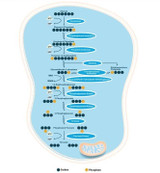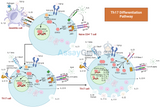Cancer & Tumour Suppressors – Mini Review
Cancer Development
Cancer is a group of diseases that involves abnormal cell growth resulting in malignant tumours/ malignant neoplasms. Cancer is a leading cause of morbidity, with 14 million new cases diagnosed and 8.2 million people dying from cancer in 2012 (World Health Organisation 2015). The different types of cancers are classified by the cell type they originate from. The most common cancers are breast, colorectum, lung, cervix, and stomach cancer. There are a number of risk factors that lead to cancer development such as smoking tobacco, an unbalanced diet, being overweight, alcohol use and lack of physical activity (World Health Organisation 2015) Cancer development results in total restructuring of cell signalling pathways and in a deregulation of the physiological responses they regulate. The initiation of tumourigenesis is characterised by a number of different hallmarks resulting in the development of malignant cancer cells. A vast amount of research has identified ten hallmarks, which are traits of cancer cells. These include sustained cell proliferation, evading cell cycle checkpoints, avoiding immune destruction, replicative immortality, tumour promoting inflammatory response, promotion of invasion & metastasis, activation of angiogenesis, genome instability & mutation, cell death resistance and changes in cellular metabolism (Hainaut and Plymoth 2013).
Tumour suppressors and oncogenes
There are two types of genes involved in the regulation of cancer, oncogenes and tumour suppressors. The deregulation of physiological processes is a result of changes in inactivation of tumour suppressors and activation of proto-oncogenes (Knudson 1971, Todd and Wong 1999). Oncogenes: are genes which mutations results in a gain of function of these genes, that leads to an increase of cell growth and survival of cells (Fukasawa 2007). The amplification of proto-oncogenes can stimulate cancer progression. For example, the amplification of the transcription factor c-myc plays a role in resistance to cancer drug treatments (Denis et al. 1991). KRAS is a GTPase regulating the MAPK pathway and this gene is mutated in about 20% of human tumours resulting in a constitively active KRAS (Downward 2003). Tumour suppressors: are genes that inhibit cell growth and induce cell death. Mutations in these genes results in loss-of-function and an increase in cell survival (Fukasawa 2007). The best known tumour suppressor is p53 which regulates cell cycle progression and apoptosis and is frequently mutated in a wide variety of cancers resulting in a loss-of-function of p53, thus decreasing its effect of apoptosis (Amaral et al. 2010). Another examples is the phosphatase PTEN regulates the pro-growth signal of AKT by dephosphorylating of the lipid phosphatidylinositol- 3,4,5-triphosphate (PIP3) that activated AKT and PTEN is down regulated in about 50% of hepatocellular carcinoma (Horie et al. 2004).

window.SHOGUN_IMAGE_ELEMENTS = window.SHOGUN_IMAGE_ELEMENTS || new Array(); window.SHOGUN_IMAGE_ELEMENTS.push({ hoverImage: '', uuid: 's-f5ca30a6-0949-43ae-b11a-43b246d5ffe3' })
Recent Posts
-
Biological Role of GLP-1
Glucagon-like peptide-1 (GLP-1) is a critical hormone in the regulation of glucose met …20th Jun 2024 -
Th17 Cell Differentiation: Insights into Immunological Dynamics
Th17 cells, a subset of T helper cells characterized by their production of interleukin-17 (IL- …25th May 2024 -
Assay Genie New Asian Distributor May 2024
Dublin, Ireland — May 20th 2024 — Assay Genie, a leading supplier of ELISA Kits, Ant …19th May 2024




